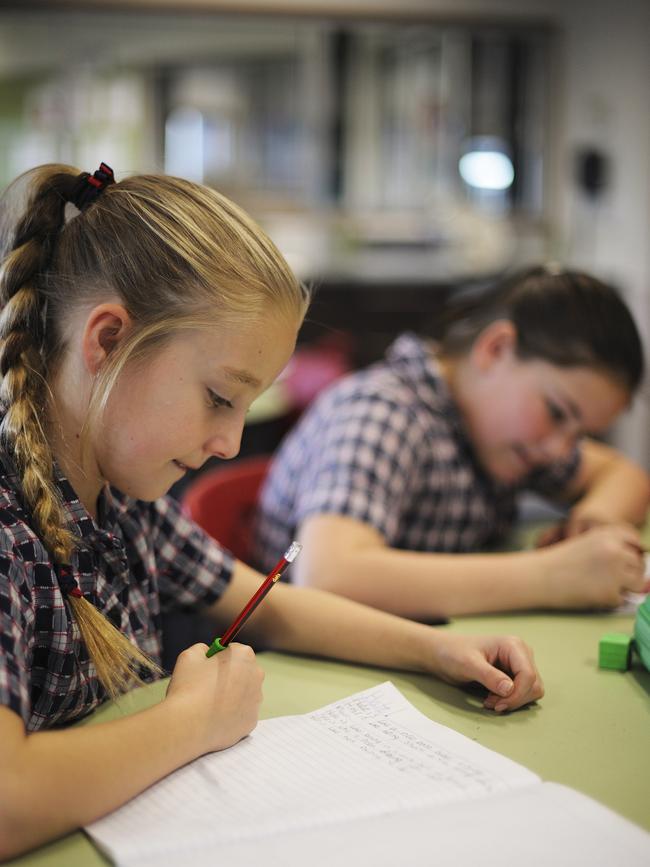NAPLAN: Pros and cons to the test people love to hate
Everyone has an opinion on NAPLAN. Some experts say it has benefits. Others that results are being misused. For pupils, teachers and parents, it can be a huge source of anxiety. Is it time to rethink NAPLAN? Take our poll.

NSW
Don't miss out on the headlines from NSW. Followed categories will be added to My News.
Northbridge student Georgia Yaghljian was one of the first pupils in the state to sit NAPLAN 13 years ago. She was in Year 3, and even back then remembers feeling the anxiety around the unknown.
Today, she is studying to become a teacher and learning about the controversial testing system that everyone from parents, teachers and pupils love to hate.
“I remember sitting the tests and as it is the first ‘high stakes’ standardised test that students take in Year 3, it can be quite a daunting experience,” the now 21-year-old told Saturday Extra.
“I think in the beginning the tests are quite easy, however as it progresses the questions get trickier.
“I am currently working as a tutor and I find that students have trouble when it comes to the few last questions — but they are always up for the challenge which is important.
“I think it is important to remember that this test is a small snapshot of a child’s academic capability.”

Annual NAPLAN testing for years 3, 5, 7 and 9 started this week for more than one million Aussie students. Because of their very nature, experts fear the Australian Curriculum, Assessment and Reporting Authority (ACARA) designed tests continue to lose credibility due to results being collated on the MySchool website allowing parents to compare schools, with many using performance as a basis on school selection for their children.
Some parents find the pressure of doing well is too much for young children and many teachers resent having to “teach to the test”.
With results back in September, pupils are tested on literacy and numeracy fundamentals, and given individual results from Bands 1-10.
For Year 3 pupils, Band 3 is the national minimum standard, while Band 4 is the minimum for Year 5, Band 5 the minimum for Year 7 and Band 6 for Year 9.
The standardised testing allows parents and teachers to understand where their child sits compared to the rest of the country, and also plots their progress over the years.
As a prospective teacher, Ms Yaghljian said there was pressure on students, and in turn teachers, to achieve marks above the national and school average.
“Additionally, in an already busy schedule, many teachers are having to ‘teach to the test’, which can sacrifice time in other key learning areas,” she said.
In a recent survey she conducted as part of her Bachelor of Primary Education degree, she found parents were split 50/50 when it came to how they felt about NAPLAN.
“Those who thought that it was necessary said that it allowed for the tracking of academic performance while informing individual, class, and school progress, funding and policymaking,” the fourth-year student said.
“Many parents responded that the results were merely used as a marketing tool for schools to compete with one another, and one response stated that a fish cannot climb a tree, relating to the diversity of students and the inequity present when conducting standardised tests.”
Ms Yaghljian also asked parents whether high stakes summative assessments such as NAPLAN were effective ways to measure students’ academic performance, with
64.6 per cent saying they weren’t.

“One parent said these kind of cumbersome tools promote a fixed mindset in students and increase anxiety in children, parents and teachers, describing it as ‘the managerialist era’s focus on data collection at its worst’,” she said.
“On the other hand, a parent highlighted that exams also assess how students learn, perform under pressure and analyse information — all crucial to being workforce-ready, responsible adults, giving them the ability to perform in all aspects of life.”
University of Sydney’s Professor Jim Tognolini described NAPLAN’s statistical indicators as ‘excellent’ but said over time results had been misused and, as a result, were misunderstood.
“NAPLAN is one piece of evidence from a source external to the school which should be combined with all the rich evidence the teacher already has with a view to seeing if there is anything new which could be used to improve student performance,” said the university’s director of the Centre for Educational Measurement and Assessment.

“My problem is that while the test is fit for purpose, the results have been misused — that is, they have gone well beyond the original purpose — and misunderstood.
“I do see value in having some evidence external to the school for all students on four occasions in the 12 years that they are at school.
“If you ask whether we need one or not, I would say yes. If you ask me whether it is worth the cost, I would probably say no.
“We could achieve the original purposes of NAPLAN using a sampling approach and save a lot of money.”
This year, 70 per cent of schools will participate in NAPLAN online, in preparation for a full transition to NAPLAN online in 2022 — a positive outcome, according to Prof Tognolini.
A lot of pressure was placed on pupils because it had become a ranking tool for schools, something he described as a misuse of the results.
“It was never designed for use in a MySchool environment and the consequences of such a tool have made what was designed as a low-stakes test, high stakes,” he said.
“This has decreased the validity of the test and its results.
“The test is good quality and as such should be seen for what it is.
“But the misuse and misinterpretation of the results have devalued the credibility of the test in the eyes of many teachers in the profession.
“The harm is not in having students sit down in an interesting and different environment and respond to some very good and challenging work that they cover in school — the harm is that the results are being misused and as a consequence many students are feeling pressure that was never intended.
“However, this is not a fault with the test, the teachers or the students themselves, who under different conditions can get great good out of the test.”
Education strategy expert Ki Yan Baldwin said NAPLAN was a point-in-time measurement of a narrow set
of parameters that didn't necessarily offer timely or actionable information for teachers and parents to better support students.
“While I understand that metrics are an important part of helping students improve — and it’s an important part of my own methodology — I think there are better ways to do it,” the CEO and founder of Kalibrate Consulting said.
“The current socialisation of NAPLAN can create judgment and marginalisation that is detrimental to development of confidence and healthy conceptions of self, especially in competitive academic environments.
“Some families in the community send their children to be ‘coached’ into preparations for model results in NAPLAN — as such, NAPLAN results are not necessarily a good indicator of a student’s natural ability, critical-thinking skills, practical application or other key metrics that would yield more valuable data on how to
improve their outcomes and realise their full potential.
“And despite this orchestration, so much emphasis is placed on various ‘formalised’ tests by parents, schools and policy makers.”
Ms Baldwin said the way NAPLAN was devised also reflected the need for policymakers to gain tangible, concrete data that was easily computable, or could be used for the purposes of debating or validating policy.

She said the messaging around NAPLAN had to become more positive and constructive than it currently is.
“There are many more ways to use NAPLAN than for just the short-term data — think about how it could be used to help build confidence, resilience and motivation,” she said.
“I think where efficiency is favoured over the wellbeing development of individual students, it can create too much pressure … I have seen many kids feel a sense of failure or that they’ve let their parents and school down.
“This can silence them, create further problems down the track, particularly anxiety and depression.”
Riverview mother Lorna Baker said her 10-year-old daughter Evelyn sat this week’s tests with more confidence, knowing what to expect.
“She did writing online which is ridiculous at her age,” Ms Baker, 36, told Saturday Extra.
“She had 42 minutes to write a narrative and only typed two paragraphs — if she could have written the narrative old-school style she could have written much more.
“It just captures results of my children over one week of their school life. It doesn’t show anything else that they have learnt — what if they are having a bad day?
“They’re only young once.
“It (NAPLAN) should be taken away altogether.”
More Coverage
Originally published as NAPLAN: Pros and cons to the test people love to hate





